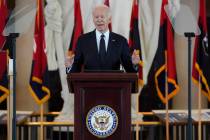Nevada just one of many states left hanging by Xerox health-system woes
Xerox is under fire for its troubles building Nevada’s online health insurance exchange.
But Nevada Health Link isn’t the first insurance-related initiative Xerox has had issues launching. It’s not even the second, third or fourth for the Connecticut-based contractor.
In fact, Xerox is a common thread in what public officials nationwide describe as a string of struggling, health-related projects.
In New Hampshire, an upgraded Medicaid payment system that was to debut in 2007 didn’t go live until spring 2013. Xerox missed a 2010 delivery date for Alaska’s new Medicaid payment program, and the system, which rolled out Oct. 1, still has payment glitches. There’s even a federal lawsuit in Texas over a municipal ambulance-billing system.
NEVADA’S FRUSTRATIONS
Those difficulties have implications for Nevada. Officials from Gov. Brian Sandoval to the board of the Silver State Health Insurance Exchange, which runs Nevada Health Link, are pressuring Xerox to fix the website’s glitches as enrollment languishes.
But officials in other states say Xerox hasn’t made it easy to fix flaws in their new insurance software.
“It’s been incredibly frustrating working with Xerox, for the most part,” said Richard Opper, director of the Montana Public Health and Human Services Department, for which Xerox is developing a Medicaid payment system. “They have not always had the right people assigned to the project — people who have understood Montana’s needs or expectations, which were outlined very clearly in our contract and contract amendment. I think Xerox was honestly in over their head in a new business realm they didn’t understand.”
Xerox executives counter that they have four decades of experience developing health systems. Plus, designing and testing Nevada Health Link — the insurance marketplace through which consumers can buy coverage to comply with the Affordable Care Act — happened in a brief, 16-month time frame with an immovable Oct. 1 deadline. Also not helping is a constant stream of federal edicts to implement the act.
Nor is Xerox the only vendor to have software hitches in exchanges. CGI’s federal exchange, unveiled Oct. 1, is still unable to accept premium payments, enroll consumers in Medicaid or calculate federal premium subsidies. Oracle’s exchange website for Oregon premiered Oct. 1 with more than 1,200 software bugs, The Oregonian newspaper has reported. And Noridian Healthcare Solutions’ Maryland exchange routinely loses customer information and has forced the state to turn to paper and telephone sign-ups.
But Nevada’s exchange-related problems are unique. For one thing, Nevada alone hired Xerox for a complete build, according to a December report from the Pew Charitable Trusts. And it’s not clear how much state officials knew in advance about the company’s track record with health-related systems.
What is certain is that the exchange has fallen woefully short of expectations.
FLAWED SYSTEM
The debate over Nevada Health Link’s enrollment troubles came to a head Feb. 13, during an exchange board meeting.
Board members noted that the site had enrolled just 16,000 of the 118,000 Nevadans it had forecast in its first six months. What’s more, only 22,000 of the 82,000 consumers declared eligible for coverage through the site had actually chosen a plan.
Board members attribute some of the low enrollment to Nevada Health Link flaws. Xerox missed multiple deadlines on the website build, and has yet to complete the part of the system where premium invoices are created, enrollment details are sent to insurers and consumers can move into new plans if their employment or household conditions change.
Board member Lynn Etkins called the system failures “catastrophic,” and said it’s time to create a “disaster recovery plan.”
On Thursday exchange Executive Director Jon Hager announced his resignation, effective March 14.
The exchange may want to think about drawing up that recovery plan sooner rather than later: If history is any indication, it could be years before Xerox fixes Nevada Health Link’s problems.
It took eight years for New Hampshire’s Medicaid payment system to open. Started in 2005 and due in 2007 at a budget of $60 million, the system finally came online last April at a cost of $90 million. State officials said in early 2013 that some of the delays came from bells and whistles requested by federal and state governments, but others traced back to Xerox, which took over the project when it bought original contractor Affiliated Computer Services in 2009.
Xerox fell behind on building Alaska’s Medicaid payment system. Since Alaska officials took the system online three years after schedule, in October, the website has suffered “unacceptable” problems with timeliness and accuracy of payments, said Karen Perdue, president and CEO of the Alaska State Hospital and Nursing Home Association. More than 60 percent of association members said in a February survey that the system hasn’t improved since fall.
“(Xerox) purported they did know our system, but then they said every state is unique, with all of these specialized edits that have to be on the system, and I guess that is the case,” Perdue said.
Now, Alaska Medicaid owes the state’s providers $200 million in back payments.
“The stories are pretty heartbreaking. Providers are having to go into their kids’ college funds to float cash flow,” Perdue said.
Xerox won a $70 million contract in 2009 to overhaul Montana’s Medicaid payment process. It has already missed several deadlines, and there’s no way the system will be ready for its fall 2015 delivery date, Opper said. A report from the state’s Health and Human Services Department said Xerox “has struggled to provide qualified experts for the project.”
Montana officials and Xerox are talking about new delivery plans and deadlines, and the state is fining Xerox at least $30,000 for every day it is late on any system milestone.
It’s not just Medicaid and exchange systems that are tripping up Xerox. There’s also trouble in Texas, where Houston filed a federal lawsuit in July against the contractor over concerns about its billing and collections system for emergency medical services. Affiliated Computer Services was Houston’s initial vendor.
“The city has been frustrated in its attempts to obtain financial and account information related to the company’s billings for EMS and ambulance transports,” Houston City Attorney David Feldman said in a statement. “The company’s seeming inability to provide the city with basic and accurate account and financial information has led to concern about their business practices, regulatory compliance and compensation.”
With that history, you might ask how Xerox got its $72 million contract with the Nevada exchange. It was a relatively simple process, but there are gaps in what state officials will divulge.
HOW XEROX WAS CHOSEN
The state’s hiring of Xerox “was very much a standard procurement process that is essentially an industry standard at the government level nationally,” said Kimberlee Tarter, deputy administrator of Nevada’s Purchasing Division. “It was a very consistent process, and the process we follow for all of our contracts.”
That protocol started with a request for proposals to build the site. Four companies responded: Xerox, Deloitte, Choice Administrators and KPMG. The four bids were reviewed by a panel of state managers who have a background in either health or information technology, Tarter said.
Xerox won the job because it scored highest on criteria such as financial stability; demonstrated competence; experience and performance on comparable contracts; expertise and availability of key personnel; and cost. Nevada law requires any contract go to the highest-scoring company.
Selection panels evaluate demonstrated competence and performance based on the bidder’s resume and reference letters sent to the state. Sometimes, state officials receive negative references, Tarter said.
Tarter said she could not disclose Xerox’s references or discuss what the references said because that information is considered competitive information for the company.
But Xerox told the Review-Journal that it has an extensive history with health-related systems, including 40 years working on Medicaid programs. Spokeswoman Jennifer Wasmer said the company had the first Medicaid claims system to be certified by the Centers for Medicare and Medicaid Services. Xerox has developed, implemented and received certification for 31 state Medicaid programs since the 1970s, Wasmer said. The company is not involved in Nevada’s Medicaid system.
Recent Medicaid troubles have come from Xerox’s new Health Enterprise platform, a “complex system based on millions of lines of code,” Wasmer said.
Health Enterprise and Nevada’s “first-of-its-kind” exchange are “both extremely complex technological pursuits,” she said. “This is an area in which Xerox has proven expertise.”
It’s not unusual for a large, complex project such as a Medicaid management platform or a state insurance exchange to “encounter challenges” during roll-out, Wasmer said.
Xerox has also acknowledged its troubles in Nevada. Wasmer told the Review-Journal on Feb. 9 that Xerox had underestimated what would go into creating Nevada Health Link.
“The team Xerox assembled worked diligently to plan and deliver on time, but the system we used as a base platform for (Affordable Care Act) enhancements required more work than was anticipated,” she said.
The question now is how to make the system whole.
WHAT COMES NEXT
Xerox’s national health care experience provides the foundation it needs to make Nevada Health Link a success, Wasmer said.
“In all of our projects, we keep track of what works and lessons learned with a goal of sharing technological, programmatic and operational best practices across our government health care solutions group. We recognize and regret the challenges that have confronted Nevada Health Link. Xerox’s teams are moving quickly to resolve the system’s issues and to help Nevadans get access to affordable health care through the state’s health insurance exchange. We have the technical background and the thought leadership to get this right — and we’re bringing all of it to bear in Nevada.”
But the exchange board is getting impatient. Board members said they were willing to consider all options, including firing Xerox and hiring another contractor, or even joining the federal exchange. On Friday, Mike Willden, director of the Nevada Health and Human Services Department, recommended that the board consider bringing in additional vendors to assist Xerox in getting the job done.
Their hands are somewhat tied because of a November amendment to the 2012 contract. Nevada has paid only $10 million of the $72 million agreement because it’s not shelling out for components Xerox hasn’t finished. But the new contract doesn’t allow for damages such as the $30,000-a-day charges in Montana. That’s because Xerox delivered by Oct. 1 a system that at least lets consumers choose and pay for plans.
Sandoval spokesman Mac Bybee said the governor recently met with Xerox CEO Ursula Burns in Las Vegas and “had a pointed conversation regarding Xerox’s failure to perform its obligations under the terms of its contract with the (Silver State) Health Insurance Exchange.”
“Ms. Burns committed the full resources of Xerox to correct the problems associated with Nevada Health Link at that meeting,” Bybee said. “Additionally, the exchange board is exploring relationships with other vendors that could assist Xerox with improving the system and resolving these issues.”
Exchange spokesman CJ Bawden said it monitors Xerox’s progress daily.
“The exchange knows that many applicants have faced difficulty with the enrollment site and long wait times on the phone with the customer call center, and will make sure those problems are resolved,” he said.
Other jurisdictions have taken various approaches to patching problems.
The federal government fired CGI in January, a month before its contract expired, and signed a new agreement with Accenture to finish its Healthcare.gov build-out.
Replacing the contractor was smart, Perdue said, because it meant “fresh eyes on the situation.” But Alaska is still working with Xerox on its system.
“It’s really tough. You can’t go back to the old system, so you’re kind of stuck dancing with the one that brought you,” she said. “You have to have a way of communicating and figuring out how to change things. The question is whether Xerox has done enough of the disruptive approach so they don’t have the same people looking at the problem who couldn’t figure it out before.”
It took a Feb. 4 legislative hearing on doctors’ Medicaid-related financial problems to finally give Xerox “a sense of urgency,” Perdue said.
In Montana, officials are committed to working with Xerox to fix Medicaid’s problems. Xerox seems lately to have gotten “serious about refocusing its effort,” Opper said.
But he added that it’s important not to waste too much time negotiating new deadlines and system designs — something Nevada exchange officials did when they amended the contract to extend some of Xerox’s delivery dates from last summer to April.
“(Xerox) thought the solution would lie in talking us into changing our standards and requirements rather than trying to understand and fulfill them,” Opper said. “If they have a better and cheaper way to get us to a point that satisfies our needs and requirements, that’s great. But I think they spent an inordinate amount of time early on trying to get us to change our expectations. They’re doing a lot less of that now. They’ve finally gotten the message, and we’re cautiously optimistic.”
Xerox got the message because Montana officials could fine the company heavily, and they’ve spoken frankly to Xerox about what’s at stake for the company, Opper said.
“You’re not getting the sign-ups you should be getting for a very good program, and a pretty high proportion of that could be from Xerox’s failure to deliver on its problems. There has to be a strong sense of urgency there. I think Xerox’s national reputation and its ability to survive to a degree is really dependent on how they address this situation with the Nevadas, Alaskas and Montanas of the world.”
Contact reporter Jennifer Robison at jrobison@reviewjournal.com. Follow @J_Robison1 on Twitter.























